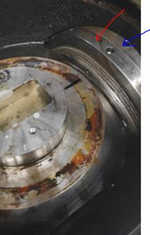Hallo,
Design philosophy of ball valve is that either ball or seat will worn out overtime (after dozens if not hundreds cycles), then it would be logical if seat(s) should be the one that can be 'easily' repaired or replaced. Smaller size and weight shall compared to ball. Thus, fully welded between seat against seat pocket best to be avoided.
Please note that ball and seat sealing area is quite delicate, thus adjustment after both are in place (inside the valve prior closing the bonnet) often required.
Top entry ball valve have limited access to retract ball and seat. some design that I've seen:
- Seat threaded (in) against seat pocket/adapter. And once ball is in place then it is threaded out until perfect sealing achieved between ball and seat. Later seat(s) are secured either with spot weld or some mechanical stopper.
Special tool to put and retract the seat is required.
- Spring(s) to pushed seat against ball. Be cautious, in the event of putting in / pulling out the ball then seat(s) need to be secured first on its position (pushed out against ball). Again special tool is required.
- Rising Stem Ball Valve (RSBV) 1.0 uses the thermal expansion method after seat being press-fitted into seat pocket. Don't know about recent RSBV seat design.
- T31 (not top entry) is to install the seat first and weld the body afterwards. (rotating) Seat has some degree of movement since it is designed to accommodate uniformity on worn out.
Might missed some details, since days of me installing/removing seats is years behind.
regards,
D

